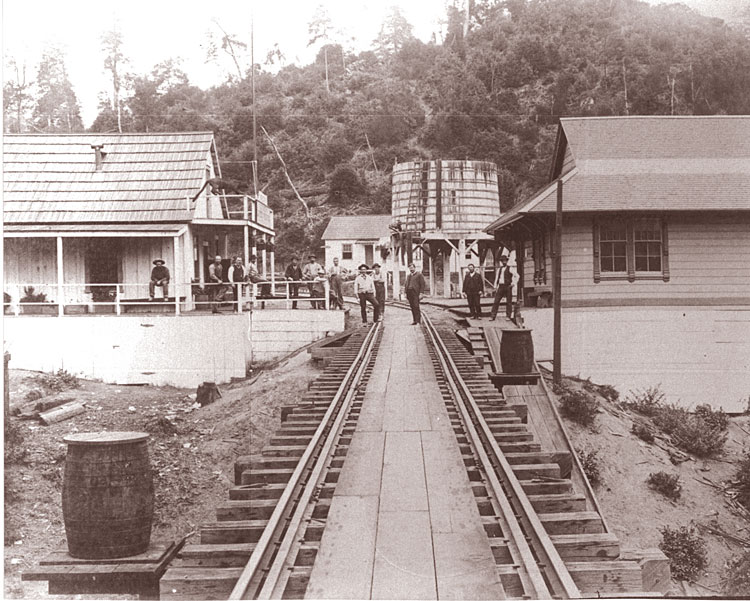By Kevin Newhouse

But did you know that between 1883 and 1923, the forest was harvested so heavily that today’s park is considered a second growth forest? In fact, the Forest of Nisene Marks became the first second-growth State Park in CA when it was officially dedicated in 1963. The forest, however, was never clear-cut. There are still quite a few old-growth redwood trees in the park today.
Prior to the 1880s, the Forest of Nisene Marks was relatively untouched land. The native Indian tribe that inhabited this land didn’t have much need for going into the forest. All the food and supplies they required could be found along the outskirts of the forest, on the flat land, in the creeks, or at the beach.
After the land was granted to various members of the Castro family in 1833, the main industry in Aptos and most of Santa Cruz was leather. To have a proper ranch to raise the cattle for their hides, you need flat land. Cows don’t do so well with the extreme terrain you find in the forest so there was very little interest in that area.
This would all change once the railroad made its way to Aptos. The logging industry took charge and the forest became prime real estate.
It was around this time that Carmelita Fallon decided to sell her acreage above the town of Aptos. Most of her land lie along Aptos Creek and contained an approximate 140-million board feet of prime redwood trees. Several key members of the Southern Pacific Railroad Company saw this as an opportunity to potentially log the land for a very large profit.
On July 10 1882, the Loma Prieta Railroad Company was formed to extend a standard gauge spur line from the main line in Aptos 3.7 miles up along Aptos Creek to the junction of Bridge Creek and Aptos Creek, then to eventually extend it further into the forest. One can only imagine the difficulties faced when attempting to build a railroad in that terrain.
Two hundred Chinese graders were employed to build the main road, aka “The Fire Road” at a wage of $1 per day. The road was built extremely wide for the standard gauge railroad. The problem with standard gauge though is the difficulty and inefficiency to navigate sharp turns. With standard gauge, you want to be aggressive and drive as straight and long as possible. In order to achieve this, they had to cut the ravines and build trestles. Some of the bigger trestles were actually built in Oakland and were shipped to Aptos where they were put together.
Several narrow gauge spur lines were also built for navigating into gorges, gullies and steep areas of the park.
The Loma Prieta Lumber Company incorporated on November 26, 1883 with the sole purpose of logging the recently acquired land above the town of Aptos.
While there were several smaller logging camps within the forest, the town of Loma Prieta was established about 3.5 miles up Aptos Creek.
At its peak, the population was approximately 300 people. In addition to the houses for the logging company directors and employees, there was a railroad station, post office, Wells Fargo telegraph office, saloon, company store, a small hotel and a one-room schoolhouse.
The Loma Prieta Lumber Company also built a huge sawmill where they could process their recently felled timber. This was not a small operation. At one point they were producing 140,000 board feet of lumber per day! Just to put that in perspective, it takes about 14,000 board feet to build an average single family home. In fact, the Loma Prieta Mill was the biggest mill site in Santa Cruz during the 19th century.
The Loma Prieta Lumber Company operated from 1883-1923. During this period the forest was logged in different areas based on land ownership and technology available. It was not logged in a linear fashion.
The forest was episodically logged by various operations into the 1960s, mostly towards the entrance of the park, but most of the “big stuff” wasn’t logged past the 1920s.
It’s hard to believe an operation of that size occurred in the park today. To the average person, there is very little indication of the town of Loma Prieta. You really have to know what to look for to see evidence of the site. Prior to the flood of 1982, you could drive all the way into the Loma Prieta town site. After the flood, the cars were restricted to the Porter picnic area. The site of the Loma Prieta Mill, however, is much easier to spot thanks to the information board and resting area marking the location along the fire road.
There is so much more to the story but it would be impossible for me to tell it all in this short article. Luckily we have a very special opportunity to learn more about the Loma Prieta Mill Site from Dr. Marco Meniketti, an Anthropological Archaeologist and Professor at San Jose State University, who has spent the past 3 years at the site of the Loma Prieta Mill doing research and trying to find out what evidence of the mill still exists.
He will be presenting his research on Saturday, April 14 from 2:00-3:30 p.m. at the Rio Sands Hotel Community Room. The event is being sponsored by the Aptos History Museum the cost of the event is $15 for Aptos History Museum members and $20 for non-members. Please contact the Aptos Chamber of Commerce at 831-688-1467 to reserve your seat today!
•••
For more information about the Aptos History Museum, upcoming events, or becoming a member of the museum, please visit www.aptoshistory.org and follow us on Facebook and Instagram @aptos_history_museum.